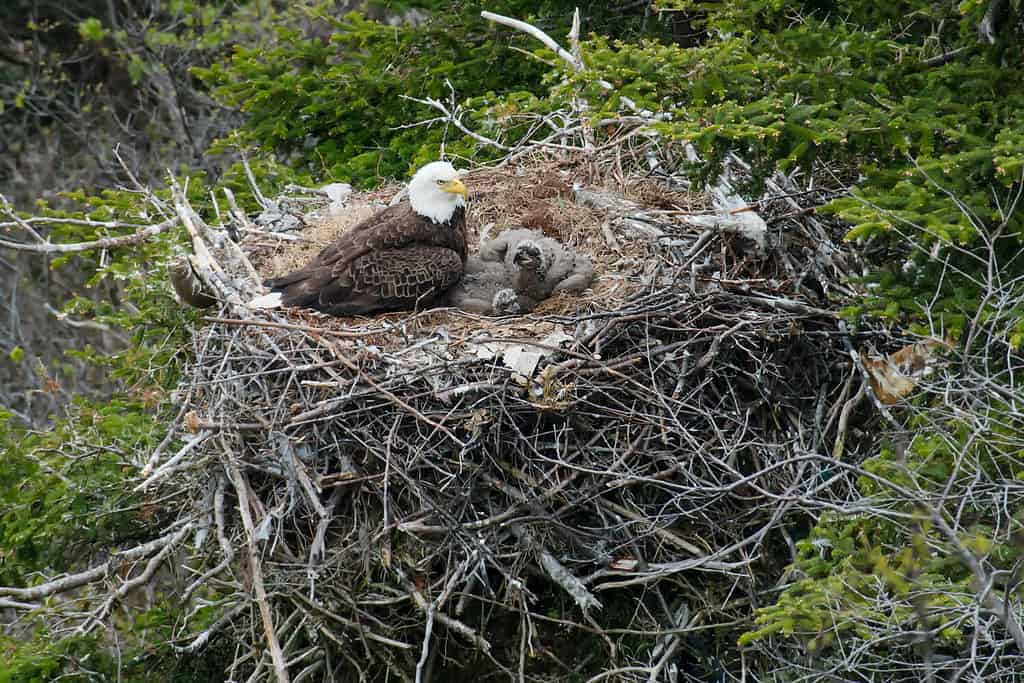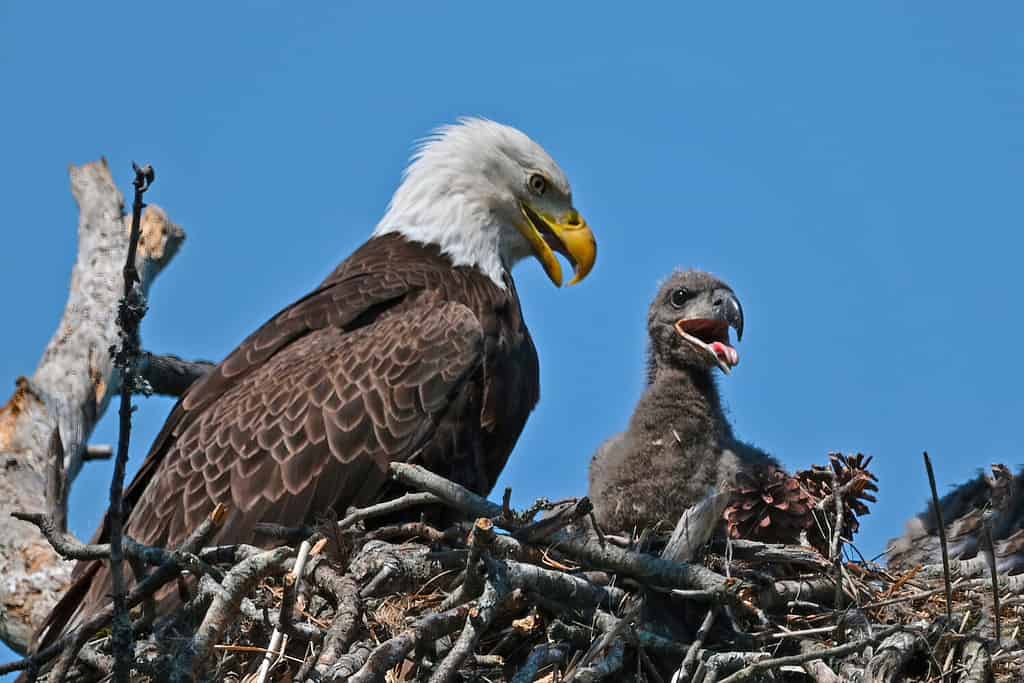The national symbol of America, bald eagles can be found across the contiguous United States, Canada, and Alaska. Though these birds were once on the endangered species list, the bald eagle population has rebounded in recent years thanks to conservation efforts. In 2020, 71,400 nesting pairs of bald eagles were recorded in the United States, with a total population of 316,700 eagles. This positive growth trend relies on successful breeding, egg laying, and eaglet rearing. Let’s take a look at how many eggs eagles lay and what happens after they hatch.
What Do Bald Eagle Eggs Look Like?

Bald eagles lay eggs in nests that are extremely large.
©RLS Photo/Shutterstock.com
Eagles lay large eggs that are dull white and slightly more rounded than a chicken egg. Eagle eggs measure around 2.7-3 inches long and 2-2.2 inches across. The exact size of the eggs depends on location, with bald eagles in the southern portions of North America laying smaller eggs than eagles up north. Bald eagle eggs weigh approximately 4-4.6 ounces. In comparison, a medium-sized chicken egg weighs around 1.7 ounces!
Eagle eggshells are fairly thick at around 0.6 mm in thickness. This thickness is critical to protecting the eggs from breaking. In the late 1960s and 1970s, bald eagle populations declined rapidly in the United States, to the point that they were added to the endangered species list. The cause of this decline was largely linked to bald eagle eggshells not being thick enough due to DDT chemicals.
Bald eagles consumed fish contaminated with DDT, which had the side effect of making the eagle eggshells so thin that they broke under the weight of incubation. The banning of DDT in the United States in 1972 eventually helped remedy the problem, and current eagle eggs have returned to a healthy thickness.
How Many Eggs Do They Lay?

The average clutch size is two eaglets.
©Paul Reeves Photography/Shutterstock.com
Bald eagles generally lay between one to three eggs in a clutch (with two eggs being the most common) and have one clutch per nesting season. Eagles may lay a second clutch if the original is damaged or lost early in the season. The female lays one egg at a time, with around two days between the eggs.
The timing of egg laying depends on the region. In the southern United States, eagles may begin laying eggs as early as October, though most incubations begin in December or January. Up north in Saskatchewan, Canada, Alaska, and the Yukon, eagles don’t lay until the end of April or May.
How Eaglets Are Raised

Parents work together to care for eaglets.
©Brian E Kushner/Shutterstock.com
Bald eagle pairs work collaboratively to raise their young, with both the male and female involved in the process. Before egg laying, the female chooses a nesting site and the pair work together to make a large nest. Eagles prefer to nest as high as possible in trees that give them a good view of the surrounding area. Average nest heights can reach 50-125 feet. They create enormous nests that may be more than eight feet across and 12 feet high. Some eagle nests have been estimated to weigh more than two tons. Bald eagles will reuse nests from year to year, provided they are still stable.
After the female lays the eggs, she is primarily in charge of incubation, while the male brings her food. The male takes over occasionally so that the female can forage for herself. Eagle egg incubation occurs for around 35 days. Eggs hatch two to three days apart in the order they were laid.
Leaving the Nest
Eaglets stay in the nest for 10-13 weeks but begin exploring the surrounding tree limbs (or “branching”) at 9-10 weeks. The young birds enter the fledgling stage at around 12 weeks. At this point, they begin venturing farther away as they learn to fly. The birds are considered juveniles until they reach their fifth year, during which they develop the distinctive white “bald” head. This is also the time that they reach sexual maturity.
Once a bald eagle selects a mate, the pair stays together until one of them dies. If their mate dies, the surviving bird takes a new mate. Even with a new mate, the eagle may continue to use the previous nest, as eagles have strong nesting site fidelity. Bald eagles can live 20-30 years in the wild, meaning they could potentially have up to 25 years of egg laying.
The photo featured at the top of this post is © iStock.com/LagunaticPhoto
Thank you for reading! Have some feedback for us? Contact the AZ Animals editorial team.







